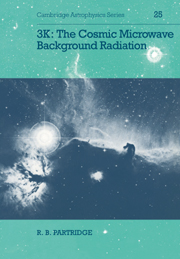Book contents
- Frontmatter
- Contents
- Preface
- 1 Cosmology
- 2 The early history of CBR studies
- 3 Radio astronomy
- 4 The spectrum of the CBR
- 5 What we learn from observations of the CBR spectrum
- 6 Searches for anisotropy in the CBR on large angular scales
- 7 Searches for anisotropy in the CBR on small angular scales
- 8 What do we learn from the angular distribution of the CBR?
- Appendix A A measurement of excess antenna temperature at 4080 Mc/s
- Appendix B Cosmic blackbody radiation
- Appendix C Recent results
- Index
5 - What we learn from observations of the CBR spectrum
Published online by Cambridge University Press: 17 September 2009
- Frontmatter
- Contents
- Preface
- 1 Cosmology
- 2 The early history of CBR studies
- 3 Radio astronomy
- 4 The spectrum of the CBR
- 5 What we learn from observations of the CBR spectrum
- 6 Searches for anisotropy in the CBR on large angular scales
- 7 Searches for anisotropy in the CBR on small angular scales
- 8 What do we learn from the angular distribution of the CBR?
- Appendix A A measurement of excess antenna temperature at 4080 Mc/s
- Appendix B Cosmic blackbody radiation
- Appendix C Recent results
- Index
Summary
The many measurements of the spectrum of the CBR discussed in the preceding chapter are consistent with a Planck spectrum with T0 = 2.73 ± 0.02 K over a wavelength range 0.1 cm ≲ λ≲75 cm. Only the submillimeter observations reviewed in Section 4.8.4 provided any evidence for a significant deviation from a thermal spectrum, and these appear to be erroneous. What conclusions may we draw from the essentially thermal spectrum of the CBR? This chapter provides some answers to that question. It is presented as an introduction to, not an exhaustive treatment of, the processes that determine the CBR spectrum. There are a number of reviews, which treat these topics in more detail, such as Danese and De Zotti (1977), Sunyaev and Zel'dovich (1980) and Bond (1988).
We begin by noting the conditions under which we would expect an exactly thermal spectrum to have been produced early in the Hot Big Bang, then consider a number of physical processes that could have distorted an initially thermal spectrum. We also consider the possibility that one or more additional ‘cosmic’ backgrounds may be present, adding to the CBR at wavelengths below about 1 mm. Finally, we investigate the constraints that the spectral measurements of Chapter 4 place on these processes.
Information
- Type
- Chapter
- Information
- 3K: The Cosmic Microwave Background Radiation , pp. 161 - 187Publisher: Cambridge University PressPrint publication year: 1995
